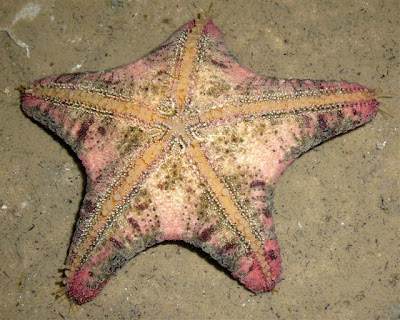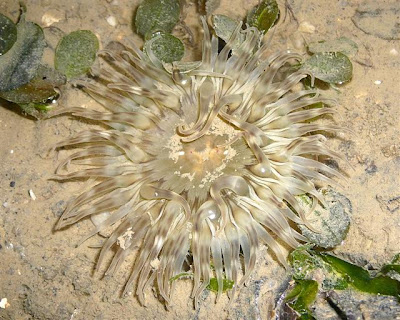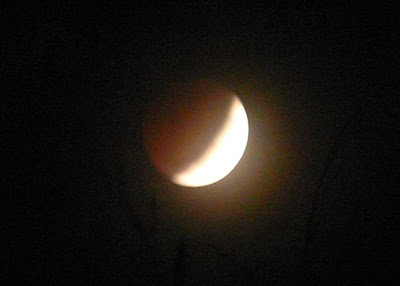Therefore, I decided to sacrifice some sleep in the predawn hours to try and see this illusive star for myself. Glad Ron was also thinking to revisit Changi so the duo of us went off in search of special stars at 4am.
Unfortunately, we couldn't find any Luidia penangensis or Luidia hardwicki that we were searching for. The tide was playing a fool of us as it did not go down as much as expected again (Yes I experienced this before!). Nevertheless, there was a bigger surprise awaiting which was revealed right at the end of the trip.

Despite the not-so-low-tide, I found this beautiful and stunning pinkish cake sea star (Anthenea aspera) which enthrilled both of us.

A closer look at the aboral surface reveals many minute pincer-like structures known as pedicellariae. The snapping actions of these structures help to defend against small attacking or settling organisms and also to keep the surface clean.
The yellowish circle part is believed to be the madroporite. The madroporite is a sieve-like button-shaped structure on the top surfaces of sea stars. It serves as the external opening of the water vascular system.

The underside of this pretty cake sea star :-)

The shore at Changi is rich in cake sea stars, and we found several others with different colour variations.

The underside of the above cake sea star.

Ron found this rather large biscuit sea star (Goniodiscaster scaber) which are surprisingly very common! I like this particular biscuit sea star because of its orange and brownish body.

How do you identify biscuit sea star?
This is a common question asked by friends whom I've brought them out for shore trips. Dr Lane's "A Guide to Sea Stars and Other Echinoderms of Singapore" stated that the oral surface of biscuit sea stars should be off-white, sometimes with purple pigmentation around the mouth and extending along either side of the grooves on the arms.

Ron also found this special four-armed Gymnanthenea laevis sea star.

From the underside, we can speculate that it is four-armed not because one was autotomized or bitten off, but it has been like that since it was a juvenile. This is so because from the centre, there are only four grooves of the arms radiating out.

There were several other types of sea cucumbers like this plain looking one, on top of the warty and thorny sea cucumbers.

There were also the usual gang of anemones like this one on top of the carpet anemones, peacock anemones etc.

Ron found this orange seahorse that we don't commonly find as compared to the yellowish ones.
However, we also had several encounter with the dead or dying.

It was sad to see this stingray died because it was hooked to a fishing line left behind at the shore. The olive snail was fast to start feeding on the body.
But the most saddening yet shocking or exciting part of the trip was during the moment where we were just about to leave the shore at the "end".

I spotted this dead body of a sea star that is HUGE in size. A closer look reveals that this is highly likely to be the body of the eight-armed sea star (Luidia maculata).

This is a photo of the eight-armed sea star taken earlier this month when I visited Changi. The arm of this particular one is about 10cm which is the usual size we see on the shores.

Guess what was the radius of the arm of this dead sea star found? It is about 20-30cm long! My ruler reads 30cm in maximum.

The central disk itself is already about 8cm in diameter! What a gigantic sea star!

There was not only one of such carcass found but FOUR.

Can you see how huge these eight-armed sea stars can be as compared to the 30cm ruler?

This fourth one had most of its arm already detached. However, it wasn't rotting as badly as the above few.

One can see that its arm still look quite fresh, with patterns similar to the ones we seen alive previously.
We were puzzled and caught in a surprise how large they can be. 20-30cm of arm lengths may be an understatement since these are rotting arms. Those alives might be even bigger.
Immediately after returning home, I referred to Dr Lane's "A Guide to Sea Stars and Other Echinoderms of Singapore" and indeed Dr Lane mentioned the eight-armed sea star to be a large sea star with eight arms, each often exceeding 20cm in length. We feel these giant stars tend to only be found subtidally since no one has seen such a large one alive in the intertidal area and that those large sea stars that Dr Lane recorded were collected in a trawled hauled from the sea bed. That is probably why we only see these large ones when they are dead and stranded on the high shore.
Today's discovery could possibly suggest that Singapore's largest sea star is not the knobbly sea star or the cushion sea star but the eight-armed sea star!


































